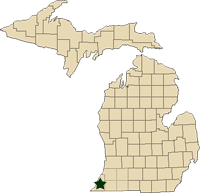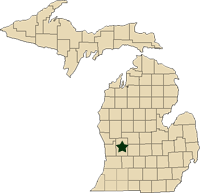Regional reports on Michigan vegetables – August 24, 2011
MSU Extension educators’ pest and vegetable updates for Michigan.
This week’s regional reports:
- Southwest Michigan – Ron Goldy
- Grand Rapids Area – Bill Steenwyk
- West Central Michigan – Norm Myers
Southwest Michigan – Ron Goldy, Michigan State University Extension
|
Weather
Temperatures averaged near normal with highs from 76 to 86oF and lows from 53 to 60oF. The area received around 1.25 inches of rain. Most precipitation occurred on Saturday, August 20. We are above the 30-year average by about 1 inch.
Crop reports
Disease continues to get worse especially in vine crops, tomatoes and peppers. Bacterial problems have caused many growers to abandon tomato plantings early. Bacterial spot continues to spread through peppers.
Phytophthora and powdery mildew can be found in many zucchini, yellow squash, fall squash and pumpkin plantings. I continue to get reports of a “black spot” on watermelon leaves and fruit. It is probably bacterial since it is worse in fields where growers have backed off on copper applications. A sample has been sent to the diagnostic clinic for confirmation.
Squash bugs and European corn borer populations remain low.
Despite disease and continual rain fall, harvest volumes remain steady and quality is high.
Grand Rapids Area – Bill Steenwyk, Michigan State University Extension
|
For the last week, daytime high temperatures have been mostly in the high 70s to low 80s, with nighttime lows in the mid to high 50s. Rainfall was variable, with most areas receiving a half to one and a half inches, although certain locales receiver more or less than that. Seasonal heat accumulation, as measured by base 50 growing degree days, is even with the recent five-year average. After mid-July, the season changed from extremely cool to extremely hot.
The 2011 celery crop is more than 50 percent harvested. The current harvest is fair to good, depending on recent wetness. Growers in the wetter areas report that tonnage is below expectations. The onion harvest has begun for some. The overall outlook is for a fair harvest throughout West Michigan.
The sweet corn crop looks good overall. Recent hot weather has caused some plantings to mature earlier than expected. Insect pest pressure is minor. My three, southern Kent County European corn borer traps had 0, 1 and 2 moths.
Zucchini harvest continue to look good, as does the winter squash. Powdery mildew is becoming more established where controls were not applied in a timely manner (see photo). Phytophthora blight is present in all vine crops, but is only a significant problem in wetter areas.
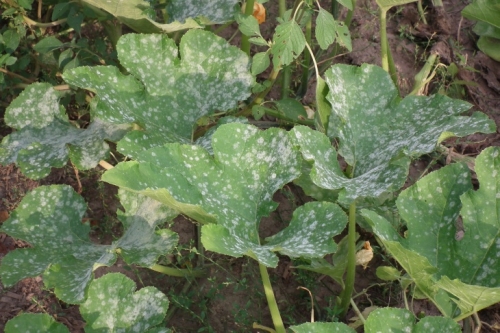
Powdery mildew on squash.
Reports regarding cabbage continue to be positive, although bacterial disease can be serious in some of the wetter areas. The crop is more than 50 percent harvested. Tomatoes and peppers have also looked good overall, but foliar diseases, primarily bacterial, have become more significant. Eggplant has developed well and harvest has been good. Some Verticilium wilt has occurred, as happens in most years (see photo).
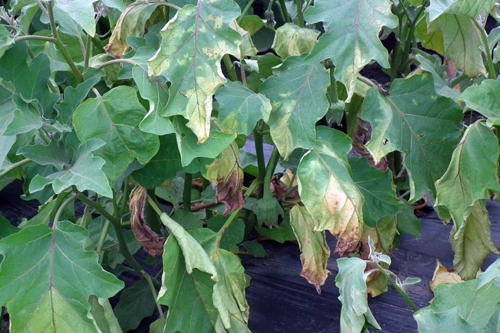
Verticilium wilt on eggplant.
West Central Michigan – Norm Myers, Michigan State University Extension
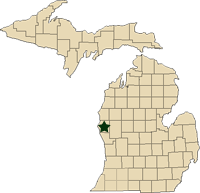 |
Oceana County got light rain on Saturday morning, August 20, with amounts in the 0.2 of an inch range. That rain wasn’t enough to effect irrigation schedules.
In asparagus, most growers are coming up on their final disease spray. If fields are in good shape disease-wise, most growers put final pesticide sprays on in late August. Growers often apply rye cover crops along with their final pesticide application of the season.
Disease pressure remains high in vine crops. Recent cool nights have greatly increased powdery mildew pressure in winter squash and Jack O’Lantern pumpkins. I am seeing a lot of ripe Jack 0’Lantern pumpkins already and since growers tell me that they are already receiving calls from buyers, that may be a good thing. Winter squash development seems to be lagging a little behind pumpkins, but is still more or less normal.
In carrots, hot weather seems to be slowing sizing of the crop. That situation means that it is all the more critical to keep good tops in to September so that carrots can size during cooler temperatures. Our aster yellows index is basically unchanged this week and aster leafhoppers are still generally low in numbers.
While I didn’t catch any European corn borer or western bean cutworm moths, my corn earworm moth catch jumped this week by tenfold. It went from two last week to 21 this week. That jump is of concern not only to sweet corn growers, but to snap bean growers, since we have had years where corn earworm was a much bigger problem on late snap beans than European corn borers.
Remember that our Oceana Research Tour is scheduled for Tuesday, September 6 from 1 p.m. to 5 p.m. That meeting is open to any interested party and agendas and maps are available from my office. This year’s tour features MSU research plots of interest to both asparagus and carrot growers.



 Print
Print Email
Email